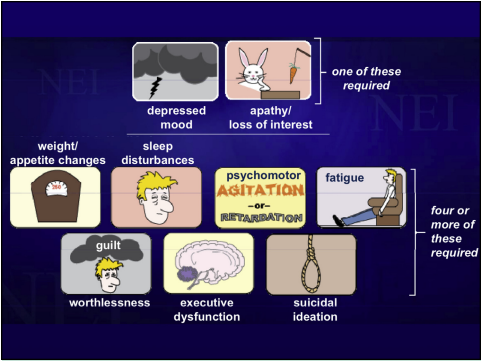Major Depressive Disorder
Major Depressive Disorder (MDD) is a major global public health issue. It affects approximately 6.7% of the U.S. adult population (ADAA, 2021). Although it can develop at any age, the median age at onset is 32.5 years (ADAA, 2021). It is more common in women than men. Treatment of MDD to full recovery remains challenging. – <50% remission rate for any drug.
Guidelines for the Diagnosis of MDD
These are regarded as the primary signs and symptoms of MDD:

Psychopharmacology of MDD
When selecting a specific type of drug protocol, consider:
- Clinical features and dimensions;
- Response and side effects of previous use of antidepressants;
- Patient preference;
- Comparative drug efficacy and safety;
- Potential interactions with other medications.
Antidepressants are regarded to have a low potential for abuse (Schifano & Chiappini, 2018).
Bupropion
It is classified as a norepinephrine-dopamine reuptake inhibitor (NDRI). Mechanism of action – Inhibits the reuptake of both noradrenaline and dopamine. It is used in the treatment of MDD, seasonal affective disorder, and nicotine addiction. It is often used “off label” for attention deficit/hyperactivity disorder, bipolar depression, sexual dysfunction, and obesity (Schifano & Chiappini, 2018).
Potential Adverse Effects and Misuse
Some of its side effects include:
- Common – Nausea, insomnia, drowsiness, constipation and headache.
- Severe – Irregular heartbeat, seizures, confusion, skin rash.
Potential for Addiction or Tolerance
A drug of low abuse potential. It causes euphoria – a “high”-like feeling, thus, has a potential for misuse (Patel et al., 2016). Some of its popular street names: “welbys”, “wellies”, “dubs” or “barnies” (Schifano & Chiappini, 2018). The administration route is an important factor in abuse potential. It can be administered orally or intranasal.
Venflaxine
It is a serotonin–norepinephrine reuptake inhibitor. Used to treat major depression, generalized anxiety, social anxiety, and panic disorder. As an “off-label”, it is used to treat fibromyalgia, migraine prophylaxis, tension-type headache, cocaine dependence, among other conditions. Available as an immediate-release (tablet) or as an extended-release formulation (capsule and tablet).
Potential Adverse Effects
Some of the side effects include:
- Common side effects – Sweating, dry mouth, sleeping disturbances, headaches, constipation and dizziness.
- Severe side effects – Violent behavior, suicidal thoughts, agitation, restlessness, acting on dangerous impulses and seizures.
Potential for Addiction or Tolerance
It is an easily misused drug. Its street name is “baby ecstasy” (Oloruntoba et al., 2018). Although it is physically non-addictive, a psychological addiction can (Schifano & Chiappini, 2018). It gives a “high” effect – This because it functions by elevating the serotonin and norepinephrine levels (feel good neurotransmitters). The level of high is not similar to other antidepressant (Oloruntoba et al., 2018)s.
Mirtazapine
It is classified as a tetracyclic antidepressants (TCAs). It is primarily used to treat MDD. It used as an “off-label” medication for generalized anxiety disorder and social anxiety.
Patients often take the medication for a period of over 40 weeks. The recommended starting dose is 15 mg/day, administered in a single dose, preferably in the evening prior to sleep.
Potential Adverse Effects
It has the following side effects that range from mild to severe:
- Weight gain;
- Drowsiness;
- Abdominal pain;
- Constipation;
- Vomiting and diarrhoea;
- Suicide ideation in the early phase of treatment;
- Serotonin syndrome – Excess levels of serotonin in the body.
Potential for Addiction or Tolerance
It is non-addictive, although it can cause physical dependence.It has a potential for addiction because of the following (Cosci, 2017):
- Even though it does not produce a euphoric high like other drugs, however, it is still misused due to the calming and mood-boosting effects.
- It has uncomfortable withdrawal symptoms; hence, leading to a cycle of dependence.
It has a high potential for tolerance. It is often used exacerbate the effects or use it to counteract the effects of stimulant drugs, such as cocaine.
References
Anxiety and Depression Association of America (ADAA). (2021). Facts and statistics. Web.
Cosci, F. (2017). Withdrawal symptoms after discontinuation of a noradrenergic and specific serotonergic antidepressant: A case report and review of the literature. Personalized Medicine in Psychiatry, 1(2), 81-84. Web.
Oloruntoba, J. O. et al. (2018). Functional recovery in major depressive disorder: Providing early optimal treatment for the individual patient. International Journal of Neuropsychopharmacology, 21(2), 128-144. Web.
Patel, K., Allen, S., Haque, M. N., Angelescu, I., Baumeister, D., & Tracy, D. K. (2016). Bupropion: a systematic review and meta-analysis of effectiveness as an antidepressant. Therapeutic advances in psychopharmacology, 6(2), 99–144. Web.
Schifano, F., & Chiappini, S. (2018). Is there a potential of misuse for venlafaxine and bupropion? Frontiers in Pharmacology, 9(239), 1-10. Web.